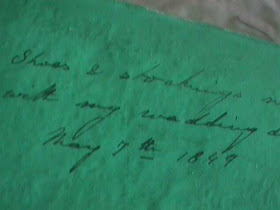Jane Radcliffe and Ron Kley of Museum Research Associates (MRA), recently discovered this elegant pair of wedding slippers while conducting ongoing research at the Vaughan Homestead in Hallowell, ME. According to MRA, they are part of the May 7th, 1849 wedding outfit of a mid-19th century proper Bostonian -- Mary Eliot Dwight (She married Dr. Samuel Parkman and became the mother of Ellen Twisleton Parkman, who married William Warren Vaughan).
These simple, elegant Parisian white satin slippers were extremely popular among brides at mid 19th century, perhaps in part due to Queen Victoria's slipper selection for her 1840 wedding. (Of course her slippers were English made by Cundry & Co. See earlier post:
http://silkdamask.blogspot.com/2012/09/whats-in-label-3-queen-victorias-1840.html) Similar foot apparel has survived in dozens of historic garment collections. This is not surprising as they are important emblems of significant events. Shoes and other accessories, such as stockings, hats, and gloves were fairly easy to store - much more so than an elaborate wedding dress. Mary Dwight's wedding slippers are of particular interest, however, as key elements of a well documented wedding ensemble. As MRA astutely observe, the charming and diminutive proportions of the (apparently original) pasteboard box in which the shoes were found (and on which their history is inscribed) is as interesting as the shoes themselves. The handwriting on the box notes "Shoes & stockings worn with my wedding dress..."
The slippers feature a square toe, interior kid lining, and dainty silk ribbon set within a channel. I have not seen the sole, but I believe them to be straight last (no right or left). It was not uncommon, even at this late date, to use straight lasts for special occasion shoes. By the mid-19th century, the last Paris shoes could be purchased in any sizable Northeast city.
The shoe label is particularly attractive - research is currently underway on the designer.
Other lesser known examples are in numerous collections such as these found in the Irma Bowen Collection at the University of New Hampshire. It has no known provenance.
The ballet flat or slipper style remains popular to this day as may be seen in the work of designers such as Emma Hope, who got her start designing ballet flats for Laura Ashley.
The ballet flat or slipper style remains popular to this day as may be seen in the work of designers such as Emma Hope, who got her start designing ballet flats for Laura Ashley.
The author thanks Museum Research Associates, the Vaughan Homestead Foundation and Astrida Schaeffer, of the Irma Bowen Collection, for generously sharing this images and information on New England footwear.





No comments:
Post a Comment
Note: Only a member of this blog may post a comment.